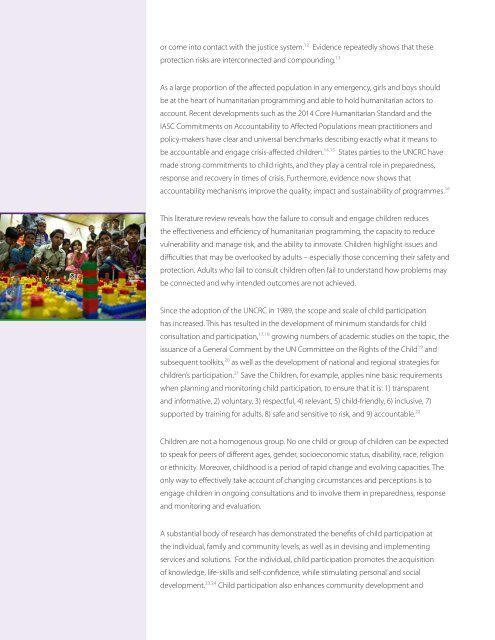putting-children-at-the-heart_full_text_final
putting-children-at-the-heart_full_text_final
putting-children-at-the-heart_full_text_final
- No tags were found...
You also want an ePaper? Increase the reach of your titles
YUMPU automatically turns print PDFs into web optimized ePapers that Google loves.
or come into contact with <strong>the</strong> justice system. 12 Evidence repe<strong>at</strong>edly shows th<strong>at</strong> <strong>the</strong>se<br />
protection risks are interconnected and compounding. 13<br />
As a large proportion of <strong>the</strong> affected popul<strong>at</strong>ion in any emergency, girls and boys should<br />
be <strong>at</strong> <strong>the</strong> <strong>heart</strong> of humanitarian programming and able to hold humanitarian actors to<br />
account. Recent developments such as <strong>the</strong> 2014 Core Humanitarian Standard and <strong>the</strong><br />
IASC Commitments on Accountability to Affected Popul<strong>at</strong>ions mean practitioners and<br />
policy-makers have clear and universal benchmarks describing exactly wh<strong>at</strong> it means to<br />
be accountable and engage crisis-affected <strong>children</strong>. 14,15 St<strong>at</strong>es parties to <strong>the</strong> UNCRC have<br />
made strong commitments to child rights, and <strong>the</strong>y play a central role in preparedness,<br />
response and recovery in times of crisis. Fur<strong>the</strong>rmore, evidence now shows th<strong>at</strong><br />
accountability mechanisms improve <strong>the</strong> quality, impact and sustainability of programmes. 16<br />
This liter<strong>at</strong>ure review reveals how <strong>the</strong> failure to consult and engage <strong>children</strong> reduces<br />
<strong>the</strong> effectiveness and efficiency of humanitarian programming, <strong>the</strong> capacity to reduce<br />
vulnerability and manage risk, and <strong>the</strong> ability to innov<strong>at</strong>e. Children highlight issues and<br />
difficulties th<strong>at</strong> may be overlooked by adults – especially those concerning <strong>the</strong>ir safety and<br />
protection. Adults who fail to consult <strong>children</strong> often fail to understand how problems may<br />
be connected and why intended outcomes are not achieved.<br />
Since <strong>the</strong> adoption of <strong>the</strong> UNCRC in 1989, <strong>the</strong> scope and scale of child particip<strong>at</strong>ion<br />
has increased. This has resulted in <strong>the</strong> development of minimum standards for child<br />
consult<strong>at</strong>ion and particip<strong>at</strong>ion, 17,18 growing numbers of academic studies on <strong>the</strong> topic, <strong>the</strong><br />
issuance of a General Comment by <strong>the</strong> UN Committee on <strong>the</strong> Rights of <strong>the</strong> Child 19 and<br />
subsequent toolkits, 20 as well as <strong>the</strong> development of n<strong>at</strong>ional and regional str<strong>at</strong>egies for<br />
<strong>children</strong>’s particip<strong>at</strong>ion. 21 Save <strong>the</strong> Children, for example, applies nine basic requirements<br />
when planning and monitoring child particip<strong>at</strong>ion, to ensure th<strong>at</strong> it is: 1) transparent<br />
and inform<strong>at</strong>ive, 2) voluntary, 3) respectful, 4) relevant, 5) child-friendly, 6) inclusive, 7)<br />
supported by training for adults, 8) safe and sensitive to risk, and 9) accountable. 22<br />
Children are not a homogenous group. No one child or group of <strong>children</strong> can be expected<br />
to speak for peers of different ages, gender, socioeconomic st<strong>at</strong>us, disability, race, religion<br />
or ethnicity. Moreover, childhood is a period of rapid change and evolving capacities. The<br />
only way to effectively take account of changing circumstances and perceptions is to<br />
engage <strong>children</strong> in ongoing consult<strong>at</strong>ions and to involve <strong>the</strong>m in preparedness, response<br />
and monitoring and evalu<strong>at</strong>ion.<br />
A substantial body of research has demonstr<strong>at</strong>ed <strong>the</strong> benefits of child particip<strong>at</strong>ion <strong>at</strong><br />
<strong>the</strong> individual, family and community levels, as well as in devising and implementing<br />
services and solutions. For <strong>the</strong> individual, child particip<strong>at</strong>ion promotes <strong>the</strong> acquisition<br />
of knowledge, life-skills and self-confidence, while stimul<strong>at</strong>ing personal and social<br />
development. 23,24 Child particip<strong>at</strong>ion also enhances community development and


